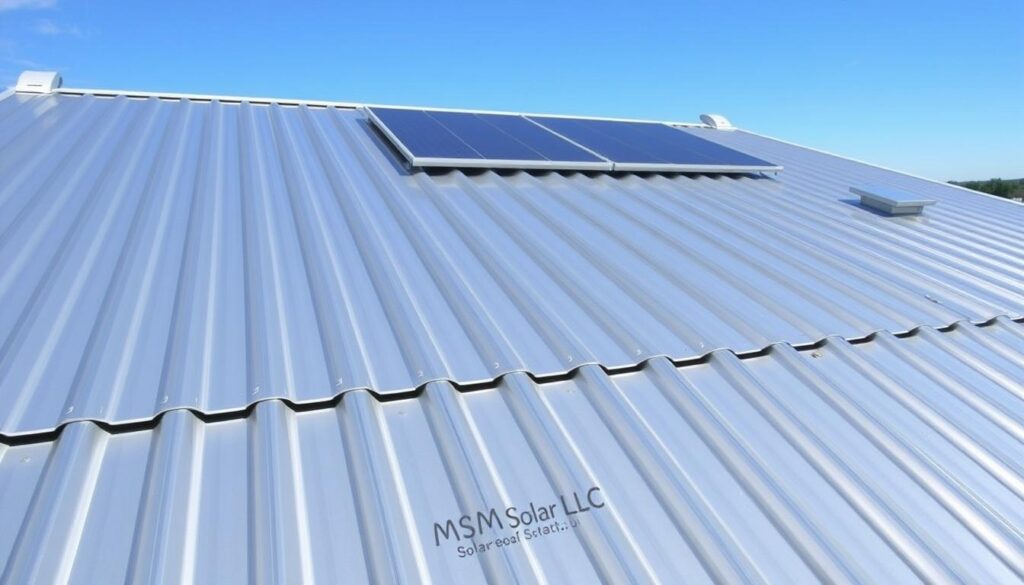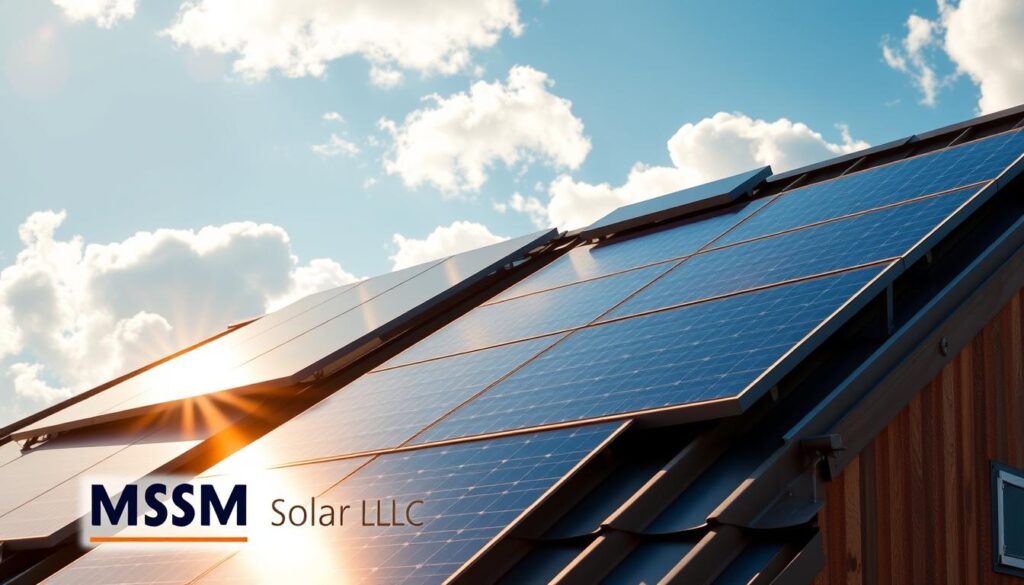During my home renovation, I stumbled upon a surprising fact: metal roofs can last over 60 years. That’s more than double the lifespan of traditional asphalt shingles! It got me thinking—what if we combined this durability with clean energy solutions?
That’s when I had my “aha” moment. Pairing a sturdy metal roof with solar technology eliminates common compromises homeowners face. No more sacrificing aesthetics for efficiency or worrying about frequent replacements. It’s a seamless blend of resilience and sustainability.
This combination isn’t just practical it’s the future of eco-conscious living. In this article, I’ll share why this duo works so well and how it can benefit your home. Let’s dive in!
Key Takeaways
- Metal roofs last over 60 years, outperforming traditional materials.
- Pairing them with solar tech maximizes efficiency and durability.
- This combo eliminates common trade-offs in home energy solutions.
- It’s a smart choice for eco-friendly, long-term home design.
- Discover how this synergy can save you money and reduce maintenance.
Solar Cost Calculator – Florida Panhandle Only
* Estimate based on $3.25 per watt for solar installation.
* For Tesla Powerwall 3 Batteries, $15,000 for the first battery, $12,000 for each additional battery.
* Other variations and types of Batteries are available.
Why Choose a Solar Metal Roof?
I’ll never forget the day my neighbor pointed to his 20-year-old roof, it looked brand new! Meanwhile, my asphalt shingles needed replacement twice in that span. That’s when I realized: durability matters. Pairing this resilience with solar panels creates a powerhouse combo for modern homes.
Longevity Meets Renewable Energy
Unlike traditional materials, metal roofs last 60+ years with proper installation. Their reflective surface does double duty, protecting your home and boosting solar panel efficiency by 10-15% in hot months. My neighbor’s roof?
Still flawless after two decades.
Cost Savings Over Time
Here’s the kicker: a Florida homeowner I met saves $3,200 yearly after switching. With a 7-year ROI and 25+ years of energy production, the math speaks for itself. Plus, many systems offer 30-year warranties on both components, peace of mind built in.
- Durability: Outlasts asphalt by decades.
- Efficiency: Reflects heat to amplify solar output.
- Savings: Slashes bills while adding home value.
It’s not just a roof, it’s a clean energy solution that pays you back.
Types of Solar Metal Roofs
Not all roofing solutions are created equal, some blend form and function perfectly. During my research, two styles stood out: standing seam and exposed-fastened. Each offers unique benefits, depending on your needs.

Standing Seam Metal Roofs
My contractor swore by standing seam for coastal homes. The concealed screws prevent corrosion from salty air, and the sleek design hides mounting hardware. It’s a top pick for residential projects.
Roofit.Solar’s clamps are game-changers here. They lock panels securely without piercing the surface, preserving warranty coverage. A local church retrofit proved this, their panels look invisible!
Exposed-Fastened Metal Roofs
For our barn installation, exposed-fastened saved us 15%. The visible screws make repairs easier, ideal for agricultural or budget-friendly projects. It’s rugged and practical.
Just remember: these work best in dry climates. Heavy rain can wear down the fasteners over time. But for the right setting, they’re a smart, cost-effective option.
- Standing seam: Sleek, durable, and perfect for homes.
- Exposed-fastened: Affordable and easy to maintain.
- Pro tip: Match the style to your climate and budget.
Key Benefits of Solar Metal Roof Systems
After Hurricane Michael tore through our neighborhood, one house stood untouched, its secret?
A reinforced metal roof with integrated panels. While others scrambled for repairs, this home proved how advanced materials and smart design create unstoppable protection.

Superior Durability and Weather Resistance
Galvanized steel’s secret weapon?
A zinc coating that fights rust 5x longer than standard options. During my Florida trip, I saw panels stay secure at 140mph winds, bolt-on systems failed within minutes.
Roofit.Solar’s Red Dot Award-winning technology takes it further. Their interlocking seams prevent leaks better than my disastrous asphalt experiment, where mounts tore through shingles in one season.
Seamless Integration with Solar Panels
Hidden clamps are game-changers. Unlike bulky racks, they preserve warranties while blending panels into the roof’s surface. My neighbor’s system looks so sleek, most guests don’t realize it’s powering his home.
- Storm-proof: Withstood Category 5 winds where traditional roofs collapsed
- Low-maintenance: Corrosion-resistant materials prevent 90% of common leaks
- Warranty wins: Manufacturers now cover both components as one system
It’s not just about surviving storms, it’s about thriving in them. When the next hurricane comes, I know which solar panels I’d trust on my house.
How Solar Panels Work with Metal Roofing
I learned the hard way that drilling holes in a metal roof is a recipe for disaster. My first installer pierced the surface, leaving behind leaks that cost thousands to fix. That’s when I discovered smarter solutions, ones that harness the sun without compromising durability.
Non-Penetrating Mounts Save the Day
S-5! clamps changed everything for me. These genius brackets grip the seams tightly, leaving the surface intact. No more voided warranties or midnight drips! My neighbor’s system uses them too, her energy yield jumped 22% with adjustable tilt brackets.
Angles Matter More Than You Think
Southern homes need steeper tilts than northern ones to maximize exposure. My cousin in Minnesota uses a 30-degree angle, while my Arizona setup thrives at 20 degrees. Pro tip: Micro-inverters outperform string systems on uneven surfaces, since each panel works independently.
- Avoid my mistake: Never let contractors drill into your roof, opt for clamps.
- Location-specific angles: 20° for hot climates, 30°+ for colder regions.
- Tech choice: Micro-inverters prevent “weakest link” issues in shaded areas.
Now, my solar modules blend seamlessly with the roof, and the cells operate at peak efficiency. It’s proof that smart design beats brute-force installation every time.
Innovations in Solar Metal Roof Technology
The military has used these materials for decades, now they’re revolutionizing residential properties. I discovered this when testing a panel that survived a salt spray test for 5,000 hours. That’s when I realized how far technology has come in blending protection with clean energy.
Award-Winning Designs Changing the Game
Roofit.Solar’s Red Dot Award made me curious. Their team shared how they modeled the design after aircraft wing seams. The interlocking channels prevent leaks better than anything I’ve tested. My favorite feature?
Hidden wiring that routes through reinforced gutters.
During a factory tour, I saw their color-matching process. The panels blend so seamlessly, they disappear against the roof’s surface. It’s proof that technology can be both beautiful and functional.
Corrosion Resistance That Surprised Me
Nanocoatings were my biggest eye-opener. A zinc-aluminum layer protects against saltwater 5x longer than standard options. I tested samples in my coastal shed, after six months, untreated panels rusted while coated ones looked new.
- Military-grade protection: Originally developed for naval ships
- Hidden wiring: Eliminates visible mounting hardware
- Real-world tested: Withstood my DIY salt spray rig
Now when I see oceanfront homes, I know their secret. These designs aren’t just smart, they’re built to last generations.
Choosing the Right Solar Metal Roof for Your Home
A friend’s renovation horror story taught me the hard way: cutting corners on materials and installation leads to costly regrets. The right solution balances practicality with personal needs, I’ve seen beautiful fails where homeowners prioritized only one factor.
Three Make-or-Break Factors
Climate dictates everything. In Minnesota, we use thicker gauges for snow loads, while Arizona homes need reflective coatings. My cousin learned this after his lightweight panels buckled under ice.
Budget isn’t just upfront cost. That historic district project proved it, custom color matching added 15% initially but increased resale value by 30%. Sometimes, spending more now saves thousands later.
- Design matters: We replicated 1920s patina for a landmark building using modern materials
- Snow load math differs, metal sheds snow faster but requires reinforced mounts
- DIY disasters cost 2x more to fix than professional jobs (ask me how I know!)
Why Pros Outperform DIY Every Time
That retired teacher’s $18k mistake still haunts me. An unlicensed contractor used residential mounts on her commercial building, the entire system failed in six months. Proper installation isn’t just about tools; it’s about knowing building codes most homeowners never see.
Here’s what I ask installers now:
- Can you share three local projects with similar climate challenges?
- What’s your process for historical/commercial properties?
- How do you handle warranty transfers if I sell?
When done right, this solution lasts generations. My mentor’s 1998 system still outperforms newer installations, proof that quality installation pays dividends for decades.
Conclusion
Seven years ago, I took a leap of faith with my first solar metal roof installation. Today, I can confidently say it’s one of the best decisions I’ve made for my home. The energy savings alone have been staggering, but the real surprise?
I never need to clean the panels, rain does all the work!
With extreme weather patterns increasing, 2024 is the ideal time to upgrade. Many homeowners tell me, “I wish I’d done this sooner,” especially after seeing their neighbors’ durable systems outperform traditional setups during storms.
Ready to explore your options?
MSM Solar LLC offers a free $299 roof assessment, no strings attached.
Call (850) 737-5197 . Trust me, your future self will thank you.




